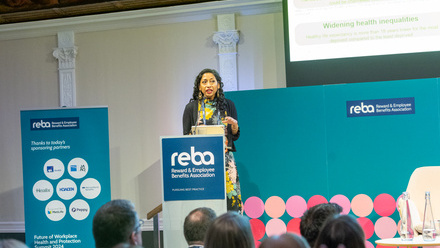REBA’s Inside Track: the top three conversations our members are having ahead of 2022

rebaLINK, our members-only online forum, provides a place for the REBA community to share ideas and ask for advice and insight, to understand how they can best support their organisation and the employees within it. Of the many questions posed in recent weeks there are three key themes that stand out, which will undoubtedly be front of mind as we enter 2022.
1. Pay in 2022
The Bank of England’s inflation target is set at 2%, however it is currently at 5.1% and is expected to peak in April 2022 at 6%. Other pressures on pay include the upcoming rise in National Insurance of 1.25% in April 2022, and an increase in the National Living Wage from £8.91 an hour to £9.50 – a 6.6% increase.
With so much volatility it is unsurprising that reward professionals are asking how others are approaching their pay budgets for 2022.
There is, of course, no hard fast and answer to this. Many organisations will shift their approach based on their own circumstances, the sector they operate in and where they are based in the world. However, rebaLINK contributors did offer some sage advice, including taking a long-term term view on pay – assessing things over the past 12 months rather than the current status quo. As well as using a range of metrics to assess the current pay conditions.
One contributor highlighted that they use: current and forecast inflation rates, GDP, unemployment rates, salary increase forecasts (from their survey providers), and their previous five years of budgets and actual increases vs how the market data has changed over the same period. They also consider exchange rates, monthly inflation figures for food, energy and fuel, and changes to tax rates.
“Often inflation figures don't tell the whole story, these extra indicators enable us to be more agile in terms of addressing any pay issues in-country for our employees. The trick is trying to figure out if it is a short term change (blip) or part of a longer trend,” added one of our members.
2. Shifts in employee benefits
For several months now we at REBA have been writing about hybrid working and how employers are introducing policies to enable this style of work. This is now largely in place at many organisations, and so attention is turning to employee benefits.
Over recent weeks questions have been raised on rebaLINK about what to do with cycle to work schemes and near-office gym memberships, but also about how to support employees who need to buy home office equipment and, perhaps the hottest topic of the moment, what to do about company cars.
Focussing on the latter, many are reviewing whether company car allowances are still relevant, with fewer people driving for work and in light of sustainability targets.
As a result, some members confirmed that they are removing these allowances and are instead shifting to a ‘benefits allowance’ that can be spent on a broad range of options. Many are also introducing EV-only car salary sacrifice schemes as a way of still offering access to a car, but one that is powered in a more sustainable way than a traditional combustion engine.
We’ll be taking a closer look at this trend early next year – so keep your eyes peeled for more insight on this topic.
3. Driving employee engagement
The war for talent and talk of ‘the great resignation’ has seen an increasing number of employers consider how they are engaging their employees. One of our professional members asked how others are utilising their employee engagement surveys to bring about change.
One rebaLINK contributor highlighted that they had moved from an annual employee engagement survey to doing one every two years, with specific pulse surveys in between.
“We only do our full employee engagement survey every other year, we use this time to collect and evaluate the data, then we share it with colleagues in a workshop environment to gain their insights to the information, creating an action plan that everyone can get involved in to some extent. We've found that doing the survey every year doesn't allow enough time to follow up on actions – the ‘you said, we did’ approach,” said one member.
Along with engagement surveys, employee recognition was also acknowledged as key to driving engagement.
Many employers on rebaLINK revealed that they are now in the process of reviewing their recognition schemes and how they work, and are exploring how else they can utilise them – be it for length of service awards through to the everyday ‘thank you’ – to drive better engagement.
Join the conversation
These three themes offer just a flavour of what’s to come in 2022. Without doubt there will be more challenges ahead. So if you’re not already a professional member of REBA, why not register (it’s free!) and you too can be part of the REBA community, to gain insight and share your own experiences on rebaLINK as we tackle the road ahead.
The author is Dawn Lewis, content editor at REBA.






